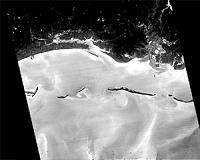 |
New Orleans, Louisiana (AFP) May 10, 2010 A French researcher has suggested an aerial map-making technique could be a valuable tool to show where oil from a giant spill is washing ashore in the Gulf of Mexico. SHOALS-1000 has been used by the US military to map coastlines but never before to measure an oil slick's presence on shore, said Antoine Cottin, a 34-year-old researcher at the University of Southern Mississippi. The technique, developed by a Canadian company, involves a plane flying over a given maritime zone carrying bundles of lasers that sweep the surface of the sea and the seabed, mapping in detail the depths and underwater terrain. Cottin believes the system would be able to determine the amount of oil washed up on beaches and the salt marshes of the Mississippi Delta. "This would let officials know exactly where they should send volunteers to help clean areas contaminated by the crude oil," he told AFP. Emergency personnel currently rely on photographs and satellite models to follow the oil slick. Pictures from SHOALS-1000 "have a much better resolution and are therefore much more accurate than those sent by the satellites," said Cottin. Another device, a hyperspectral sensor, could determine the soil type and species at risk on the ground and together they could give a better idea of the impact of the oil on a certain area, the researcher suggested. "You would be able to determine, for example, where the natural environment would be under most stress from the pollution," said Cottin, whose research partners include members of the US Army Corps of Engineers. Cottin believes it would take one week for aircraft to sweep the Gulf of Mexico's 600-kilometer (370-mile) coastline, but cautioned that the US military has only one plane with the right gear and had not yet approved the project. "I naively asked the army to see if we could use SHOALS-1000," he said, adding that although they had found the idea interesting they had given him no firm commitment. "I think they are waiting for the oil to get closer to the coast before they make a decision." The Deepwater Horizon rig, leased by the British energy giant BP, sank 50 miles (80 kilometers) off the Louisiana coast on April 22 following an explosion that killed 11 workers. An estimated 210,000 gallons of crude is spews into the Gulf of Mexico each day, feeding a massive slick that is already licking the shores of Louisiana.
Share This Article With Planet Earth
Related Links Earth Observation News - Suppiliers, Technology and Application
 NASA Captures Night Infrared View of Gulf Oil Spill
NASA Captures Night Infrared View of Gulf Oil SpillPasadena, CA (SPX) May 10, 2010 The Advanced Spaceborne Thermal Emission and Reflection Radiometer (ASTER) instrument on NASA's Terra spacecraft captured this nighttime image of the growing oil spill in the Gulf of Mexico on May 7, 2010. On April 20, an explosion destroyed the Deepwater Horizon oil platform operating in the Gulf 80 kilometers (50 miles) offshore, resulting in substantial loss of life and releasing 5,000 barrel ... read more |
|
| The content herein, unless otherwise known to be public domain, are Copyright 1995-2010 - SpaceDaily. AFP and UPI Wire Stories are copyright Agence France-Presse and United Press International. ESA Portal Reports are copyright European Space Agency. All NASA sourced material is public domain. Additional copyrights may apply in whole or part to other bona fide parties. Advertising does not imply endorsement,agreement or approval of any opinions, statements or information provided by SpaceDaily on any Web page published or hosted by SpaceDaily. Privacy Statement |